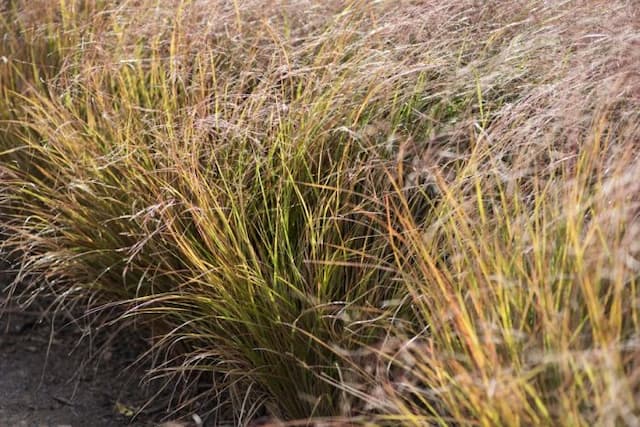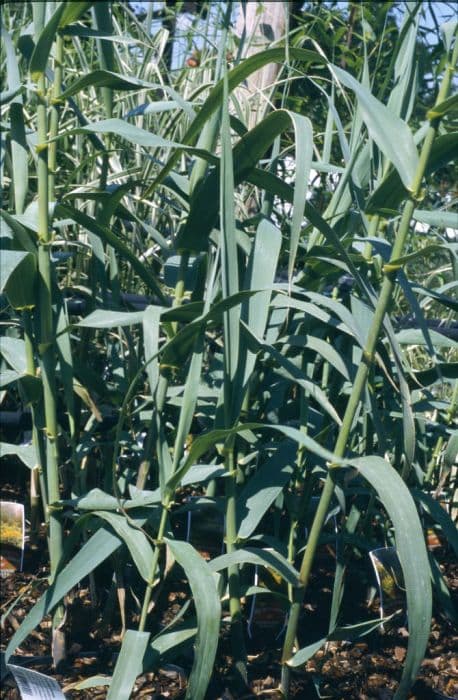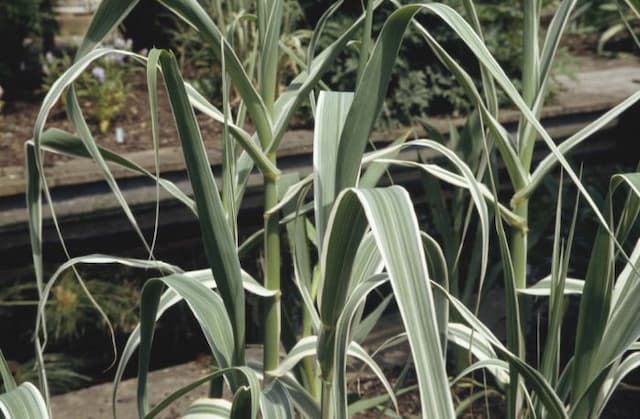Blue fescue Festuca glauca 'Elijah Blue'

ABOUT
'Elijah Blue' is a charming ornamental grass known for its striking blue-gray foliage. This grass forms dense, rounded clumps and splays out in a uniform fashion, creating a delightful tufted appearance. Each slender blade carries a powdery blue hue that can add a cooling effect to the landscape. The foliage often has a fine texture, which gives it a soft, almost feathery touch. As the plant matures, the intensity of the blue may take on slight silvery notes, providing a beautiful contrast to other garden plants. During certain times of the year, 'Elijah Blue' sends up tall flower spikes that stand above the foliage, typically displaying a lighter shade of blue or sometimes transitioning into a golden color as they mature. These delicate seed heads can add a subtle vertical element to its mounded shape. Overall, its unique color palette and neat growth habit make 'Elijah Blue' a popular choice for adding year-round interest and color to gardens, borders, and mixed containers.
About this plant
 Names
NamesFamily
Poaceae
Synonyms
Blue Fescue, Elijah Blue Festuca, Blue Mountain Grass
Common names
Festuca glauca 'Elijah Blue'.
 Toxicity
ToxicityTo humans
Blue fescue, including the variety 'Elijah Blue', is not known to be toxic to humans. There are no well-documented cases of poisoning from ingesting any part of this plant. Thus, accidental ingestion is unlikely to cause harm beyond the possibility of mild stomach discomfort as with any non-edible plant material.
To pets
Blue fescue is considered non-toxic to pets, including cats and dogs. There is no significant risk of poisoning if pets ingest parts of this plant. However, ingestion of any plant material can potentially cause mild gastrointestinal upset, such as vomiting or diarrhea, in some animals.
 Characteristics
CharacteristicsLife cycle
Perennials
Foliage type
Evergreen
Color of leaves
Blue-green
Height
1 foot (30 cm)
Spread
1 foot (30 cm)
Plant type
Herb
Hardiness zones
4-8
Native area
Europe
Benefits
 General Benefits
General Benefits- Drought Tolerance: This plant is highly resistant to dry conditions once established, making it suitable for low-water gardens.
- Low Maintenance: 'Elijah Blue' has minimal needs in terms of fertilizing, pruning, or pest control, which saves time and effort for gardeners.
- Ornamental Appeal: The striking blue foliage adds color contrast and visual interest to landscapes and gardens throughout the year.
- Cold Hardy: It can survive in cold weather, making it suitable for planting in a variety of climates, including cooler regions.
- Erosion Control: Its root system helps stabilize soil, which can prevent erosion on slopes or banks.
- Deer Resistance: Generally not preferred by deer, it's a good choice for gardens in areas with high deer populations.
- Tolerance of Poor Soils: It can grow in less-than-ideal soil conditions, including rocky or sandy soils.
- Compact Size: The small, mound-forming habit of 'Elijah Blue' makes it suitable for use as groundcover or in borders without overwhelming the space.
- Long-Lived Perennial: Once established, it can thrive for many years with proper care.
 Medical Properties
Medical PropertiesThis plant is not used for medical purposes.
 Air-purifying Qualities
Air-purifying QualitiesThis plant is not specifically known for air purifying qualities.
 Other Uses
Other Uses- Lawn Alternative: Elijah Blue fescue can be used to create a low-maintenance, drought-tolerant alternative to traditional lawns in suitable climates, providing a soft blue hue and unique texture.
- Erosion Control: Its fibrous root system helps stabilize soil on slopes and prevent erosion.
- Container Plant: Due to its compact size, Elijah Blue fescue works well in container gardens, adding color and interest on patios or balconies.
- Garden Art: The striking blue foliage can be used in creating living sculptures or garden mosaics when planted among contrasting colors and textures.
- Photographic Subject: Its unique color and form make it an excellent subject for botanical photography and as a backdrop for other plant photos.
- Thematic Gardens: Ideal for 'moon gardens' where silver and blue plants are featured to create a serene nighttime garden space.
- Craft Projects: Dried tufts of Elijah Blue fescue can be used in floral arrangements or wreaths for long-lasting decorations.
- Train Set Landscapes: The small, mound-forming grass can be used to add realistic vegetation to model train set displays.
- Green Roofing: This hardy grass is suitable for use on green roofs, contributing to urban biodiversity and building insulation.
- Fairy Gardens: The diminutive size and distinctive color of Elijah Blue fescue make it a perfect addition to fairy gardens and other miniature landscapes.
Interesting Facts
 Feng Shui
Feng ShuiThe Blue Fescue is not used in Feng Shui practice.
 Zodiac Sign Compitability
Zodiac Sign CompitabilityThe Blue Fescue is not used in astrology practice.
 Plant Symbolism
Plant Symbolism- Perseverance and Strength: Festuca glauca 'Elijah Blue,' commonly known as Blue Fescue, is a hardy plant that can withstand tough conditions. Its ability to thrive in poor soils and tolerate drought reflects the qualities of perseverance and strength.
- Peace and Tranquility: The blue-green hue of the Blue Fescue's foliage is often associated with a calming effect, symbolizing peace and tranquility in a garden setting.
- Endurance: Blue Fescue is a perennial plant, able to last multiple seasons with proper care. This longevity is symbolic of endurance and the ability to last through trying times.
- Independence: Blue Fescue doesn't require a lot of maintenance, making it a symbol of independence and self-sufficiency.
 Water
WaterThe Blue Fescue should be watered deeply but infrequently to encourage a robust root system. During the active growth season in spring and summer, watering once a week is usually sufficient, providing about one inch of water each time. In the absence of rainfall, ensure the soil doesn't dry out completely but do allow the top inch to dry out before watering again. During the fall and winter, water the plant even less, tapering off as the plant goes into dormancy. It's important to avoid overwatering this drought-tolerant plant, as it prefers slightly dry soil conditions.
 Light
LightBlue Fescue thrives in full sun but can tolerate part shade. It performs best when it receives at least six to eight hours of direct sunlight daily. Plant it in a spot that is well-lit throughout the day to maintain the vibrant blue color of its foliage. If the plant receives too much shade, it may lose its characteristic coloring and become less vigorous.
 Temperature
TemperatureBlue Fescue is a hardy plant that prefers cooler temperatures and can tolerate a range from 40 to 80 degrees Fahrenheit. The ideal temperature for this grass is between 60 and 70 degrees Fahrenheit. It can survive cold winters with temperatures as low as -10 degrees Fahrenheit but is not well-suited to extreme heat over prolonged periods.
 Pruning
PruningPrune Blue Fescue in late winter or early spring before new growth starts. Trim back the foliage to about 2 to 3 inches to remove dead blades and to maintain a neat appearance. This also encourages fresh, new growth. It is typically necessary to prune Blue Fescue annually to ensure the health and attractiveness of the grass.
 Cleaning
CleaningAs needed
 Soil
SoilBlue fescue thrives in well-drained, loamy soil with a pH range of 5.5 to 7.5. A soil mix of equal parts garden soil, sand, and peat or compost is ideal to ensure proper drainage and aeration.
 Repotting
RepottingBlue fescue, being a hardy perennial, rarely needs repotting. It can be left undisturbed for several years unless the clumps become too dense or show signs of diminished vigor.
 Humidity & Misting
Humidity & MistingBlue fescue prefers low to moderate humidity levels typical of outdoor environments, as too high humidity can promote fungal diseases.
 Suitable locations
Suitable locationsIndoor
Place in bright light, well-drained soil; water sparingly.
Outdoor
Full sun, well-draining soil, tolerate drought, minimal care.
Hardiness zone
4-8 USDA
 Life cycle
Life cycleFestuca glauca 'Elijah Blue', commonly known as Blue fescue, begins its life cycle as a seed, which upon germination in early spring, develops into a small grassy seedling. The perennial then establishes a compact, mounded tuft of blue-gray foliage, with individual blades growing up to 10 inches long. During early to mid-summer, the Blue fescue sends up slender, upright flowering stalks that bear small, blue-green inflorescences which transition to a light tan as they mature and set seed by late summer. After flowering, the grass may become semi-dormant during high summer heat, particularly in hotter climates. In the fall, the foliage often flushes with shades of purple or brown before winter dormancy sets in. Over the years, the clumps may widen and can be divided in spring to propagate new plants and to maintain vigor.
 Propogation
PropogationPropogation time
Spring
The most popular way to propagate Festuca glauca 'Elijah Blue', also known as Blue Fescue, is through division. This is typically done in the early spring as new growth starts to appear. To propagate by division, carefully lift the clump of grass from the ground using a garden fork, ensuring to keep a good amount of root for each section. Using a sharp spade or knife, divide the clump into smaller sections, each with several shoots and a portion of the root system. Replant the divisions at the same soil level they were growing at originally, water them well, and maintain consistent moisture until they are established in their new location. It's important to not let the roots dry out during the transplanting process, so working quickly and methodically can enhance the success rate of the divisions.









